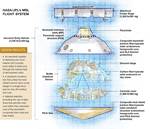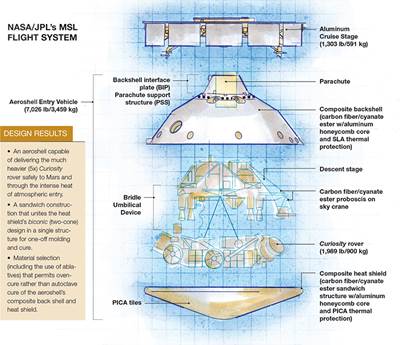The Curiosity Mars rover: Descent stage composites
Apart from the aeroshell that protected the Curiosity rover during its months in space and Mars descent sequence, only a few other parts of the mission’s descent stage were made from composite materials. Here, HPC identifies and describes them.
Apart from the aeroshell that protected the Curiosity rover during its months in space and Mars descent sequence, only a few other parts of the mission’s descent stage were made from composite materials. (For details of the aeroshell’s composites design, see “Composites carry the Curiosity rover to a safe Mars landing” under Editor’s Picks,” at top right.) Eric Oakes, a materials engineer in NASA’s Jet Propulsion Laboratory (JPL). Provided the following data:
The proboscis on the skycrane features a set of structural M55J/BCTA-1A prepreg tubes that held the ground sensing radar on the skycrane. These tubes were bonded to primed titanium end-fittings with EA 9392 room-temperature cure paste adhesive, supplied by Henkel Aerospace (Bay Point, Calif.), which offers exceptional shear strength at high temperatures.
The parachute closeout cone lid is a sandwich construction, with a circular (36-inch/91.4-cm diameter, 0.125-inch/0.32-cm thick) aluminum vented honeycomb core panel bonded between M55J/BTCy-1A faceskins. The lid was installed at the top of the back shell. During descent, the parachute canister “shot out right through the lid,” Oakes says. The lid design needed to meet launch loads and changing pressure loads — “but not be too strong to slow down the velocity of the parachute canister, since that could risk interference with the opening of the parachute.” Further, when it pushed through the back shell, the lid had to “come out cleanly and fly away,” Oakes says, “so the piece was not floating around to possibly go through the parachute or damage any other parts.”
On the rover itself, composites were employed to build three antenna radomes (see image, at right), using TenCate Advanced Composites’ (Morgan Hill, Calif.) Astroquartz quartz fiber/BCTy-1A cyanester prepreg, which Oakes describes as having a “heritage from the Deep Impact 2005 mission to a comet and beyond.” The material was ideal, he notes. “We know the values are constant, we know the loss tangent of that material, we know what its properties are.”
Further, the heat exchangers that control the rover’s temperature on Mars are also sandwich constructions. Hexcel’s trademarked HexWeb HRH 10 Nomex aramid fiber/phenolic composite honeycomb panels — 0.125-inch/3-mm thick, 6 lb per ft3/96 kg per m3—are bonded between 7075-T73 aluminum alloy facesheets. Reportedly, these panels can withstand a temperature gradient of 201°C/394°F with temperature extremes ranging from a low of -111°C/-168°F on the outside to 90°C/194°F on the inside. The honeycomb cells needed to be vented, but the core material was not supplied in that form, so Oakes “had a tool made with evenly spaced knife blades to cut a small slit in the tops of each of the honeycomb cells.”
After the honeycomb core was bonded to the inside faceskins, Oakes says that JPL “crushed a product called Aerogel into the honeycomb” to block heat from passing through the cells. Invented in the 1930s and refined by NASA, Aerogel is the lightest and lowest density solid known to exist, weighing a mere 0.00011 lb/in3. After the honeycomb cells were filled, the outside aluminum skin was bonded onto the now-vented core. Aluminum tubes bonded to the panels carried Freon refrigerant made by DuPont Chemicals & Fluoroproducts (Wilmington, Del.) through the heat exchanger.
The panels were bolted directly to the rover chassis and a multi-mission Radioisotope Thermalelectric Generator (MMRTG), the nuclear source for the rover’s energy, was installed between the panels, bolted to the rover but not connected to the panels.
Related Content
XlynX Materials BondLynx and PlastiLynx for low surface energy PP, PE substrates
Award-winning Xlynx materials use breakthrough “diazirine” technology to boost bond strength up to 950% as adhesives, primers and textile strengtheners.
Read MoreMaterials & Processes: Resin matrices for composites
The matrix binds the fiber reinforcement, gives the composite component its shape and determines its surface quality. A composite matrix may be a polymer, ceramic, metal or carbon. Here’s a guide to selection.
Read MoreMaterials & Processes: Fabrication methods
There are numerous methods for fabricating composite components. Selection of a method for a particular part, therefore, will depend on the materials, the part design and end-use or application. Here's a guide to selection.
Read MoreMaterials & Processes: Tooling for composites
Composite parts are formed in molds, also known as tools. Tools can be made from virtually any material. The material type, shape and complexity depend upon the part and length of production run. Here's a short summary of the issues involved in electing and making tools.
Read MoreRead Next
Composites carry the Curiosity rover to a safe Mars landing
From launch to touchdown, composites performed in flight and stuck the landing!
Read MoreCW’s 2024 Top Shops survey offers new approach to benchmarking
Respondents that complete the survey by April 30, 2024, have the chance to be recognized as an honoree.
Read MoreFrom the CW Archives: The tale of the thermoplastic cryotank
In 2006, guest columnist Bob Hartunian related the story of his efforts two decades prior, while at McDonnell Douglas, to develop a thermoplastic composite crytank for hydrogen storage. He learned a lot of lessons.
Read More

























